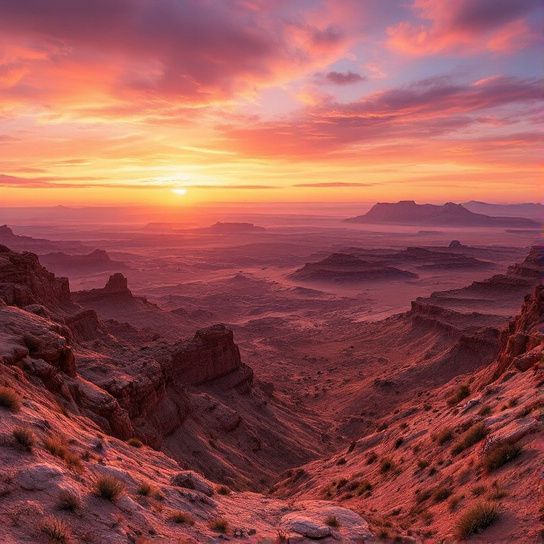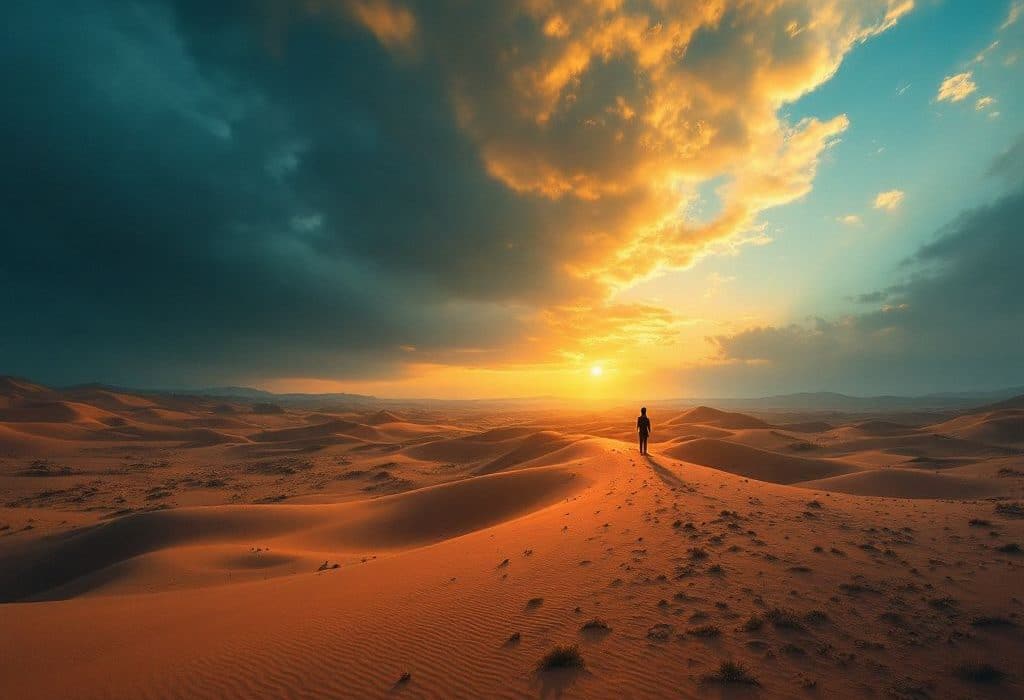Hey there! Ever thought about how the desert climate affects not just our environment but also ourselves, particularly when it comes to desert skin effects? Imagine this: You’re backpacking through the desert, mesmerized by the sweeping video-game-like horizons of golden sands and mysterious dunes. But then it hits you – the intense sun, the dry air, and before long, you’re parched, sticky, and crispy-skinned. Yikes, right? So what’s happening here, and why does it matter to you even if you’re far from these arid lands? Let’s dive in.
Understanding the Desert Climate
First things first, what are we talking about when we say “desert climate”? Simply put, deserts are among the Earth’s driest regions where annual rainfall is less than 10 inches. But this simple definition doesn’t paint the full picture. Deserts are regions of extreme temperatures, with scorching days melting into unexpectedly chilly nights. The air? Let’s say it’s drier than toast. But how do these conditions affect the environment around us, and what does this mean for desert dwellers and the Earth as a whole?
Desert Climate and the Environment
Deserts cover about a third of Earth’s land surface. That’s a chunky amount, impacting global ecosystems in significant ways. `Here’s the thing:` The harsh conditions mean that only specially adapted plants and animals can survive – think camels or cacti. They master dry protection like pros. In human terms, it’s like having the ultimate survival gear built right into your system.
How It Changes the Landscape
This scarcity of water and vegetation transforms landscapes sharply. These areas, barren as they may seem, hold hidden environmental treasures. Wind, for instance, plays a crafty artiste here, etching ever-changing sculptures in sand dunes. But the limited vegetation and precipitation also mean these areas are particularly vulnerable to erosion.
Get this: when the infrequent rains pour down, flash floods often occur, further shaping the landscape in a dramatically swift swoop. It’s mother nature on high-speed. The ripple effects? Local and sometimes global; erosion in deserts can lead to dust storms traveling thousands of miles, impacting air quality in far-off lands, and even health.

The Hidden Connection to Climate Change
Now, let’s circle back. Why should you or I care if we’re lounging comfy on a couch away from this gridded grid? Here’s the deal. Deserts are not just pointless voids. They’re sensitive reflections of climate change’s prevailing skylines. Environmental shifts here sound alarms for changes elsewhere. Like canaries in mines, desert climates show exaggerated responses to shifting temperatures and precipitation levels due to global warming.
This is substantial because deserts are getting hotter and drier, impacting our world in ways that we might not immediately see – and not just there but everywhere. For instance, spreading deserts mean dwindling habitats and shrunken biodiversity, impacting global climate patterns.
Effects of Desert Climate on Human Skin
Okay, I’ve got to admit, it would be somewhat forgetful if we didn’t talk about the firsthand experience many of us have with arid conditions: desert skin effects. Living in or visiting a desert dramatically emphasizes the very real impacts on human health, and your skin feels it the most.
Let’s be real for a sec. Dry, scaly skin that feels like it’s about to crack? Oof. Not the best feeling. The low humidity and high temperatures suck all the moisture out, and we mean every bit. Even if you just visit for a short while, the transformation feels almost instantaneous. Skin care suddenly skyrockets in your daily ‘must-dos.’
Navigating Skin Survival in Desert Conditions
You might think: slap on some extra lotion and you’re good, right? Well, there’s more to it if you’re spending more than just a quick vacay in a desert-like climate. The real MVPs here use strategies that combine prevention and response. Let’s take a peek at some tried-and-true tips to combat those pesky desert skin effects:
- Hydration Is Key: Drink up, but also, choose the right products. Look for lotions and creams with glycerin or hyaluronic acid. They attract water and keep it there like nothing else.
- Sunscreen Salvation: Don’t skimp here, especially when the sunlight’s more intense. Go for broad-spectrum sunscreens with SPF 30 or more. Apply them generously and frequently. Trust me on this one; your skin will thank you.
- Long-Lasting Moisturizers: Opt for richer formulations than you might back home. It’s not about being fancy; it’s just practical. Shea butter and coconut oil-based products give that extra oomph.
- Gentle Cleansing: The desert climate doesn’t play fair with your lipids. Stick to gentle cleansers to keep protective skin oils where they’re needed. Over-scrub and you’ll lose the game before it starts.
- 5. **Protective Clothing: Hats, sunglasses, long sleeves. Sounds tedious, but combined, they’re an excellent line of defense.
Dry Protection and Skin Care

You might be wondering why there’s such an emphasis on proactive care. Simple enough — it’s genuinely easier to maintain moisture and protection than to play catch-up after the fact. Regularly incorporating preventative measures makes the challenge of desert skin effects notably less daunting.
Balancing Internal and External Care
True care combines efforts on two fronts. Internal hydration gets vastly overlooked. Drink water throughout the day, replace electrolytes accurately, and balance with a nutritious diet. External cover must be attentive and routine-oriented. A pro tip to make this manageable? Set little reminders, particularly if you’re prone to skipping moisturizing steps or reapplications amid daily distractions.
The Impact and the Opportunity
So, what does this all lead to? It seems weird to think of harsh landscapes with their equally demanding challenges as “opportunistic,” but they are. The desert climate not only holds ecological importance but also offers a unique chance to adapt, innovate, and learn.

Bending Adaptation for Modern Solutions
From how we conserve water to ingeniously green architecture, lessons echo from the way desert organisms operate. I tell you, collaborating with these natural processes rather than battling them makes broader sustainability plausible and inspired.
Renewable energy harnesses like solar power? Deserts are prime real estates. Researchers and tech developers tune in to these habitats for insights into enduring, saving energy, and minimizing waste.
Building Sustainable Communities
Another often missed jest in ‘hot-take-discourse’ is how desert environments promote communal spirit. Tribes here revolve around proudly enduring life in harmony, conserving life with significant attention to detail and collective survival versus isolated living.
With climate change as pressing in the bigger picture, fostering similar dynamics and mechanisms isn’t just sensible – it’s vital. We learn a thing about thriving, aligning what’s scarce rightly, and celebrating diversity – all pivotal steps on a globally aligned sustainable path.
Finally, How Does This Matter?
Connecting back to ourselves – those sweaty hikes, redder cheeks, sometimes daunting dry days? Understanding the desert’s effect isn’t solely about immediate impacts. Broader spectrum engagement with deserts presses parity and farsightedness in nesting a beneficial global climate from adapting intelligently to what deserts afford us about living how to live resiliently – perhaps even gracefully.
This curious dynamic grasps why preparedness activated persists influentially pertinent and ageless. While we shelter indoors and coat skin against the torrid sweep and prickle, deserts ever remind us action influences compassionately rippling around sustaining momentum with hands and livings adeptly woven through knowledge in appreciating landscape bountiful despite slim conditions. So the next time that bright desert scenery appears? Breathe deep, engage meaningfully with desert stories, and support life enacted beautifully impervious to adversity.
Let’s face it, fabulous learnings reside patiently between these harsh-orange pockets, even as they dry quickly. Surely, surviving well enough together invariably presents the sweetest prize.
Frequently Asked Questions
What are the primary skin effects caused by desert climates?
Desert climates can cause several skin issues, including dryness and dehydration, due to the low humidity and high temperatures. This can lead to dehydrated, flaky, and itchy skin. Other common issues include sun damage and UV exposure, which can result in sunburn, hyperpigmentation, and an increased risk of skin cancer. Additionally, conditions like psoriasis, ichthyoses, and atopic dermatitis are more prevalent due to the dry environment[1][4][5>.
How can I protect my skin from the harsh conditions of the desert?
To protect your skin in the desert, it is crucial to maintain hydration by drinking plenty of water and using moisturizers rich in ingredients like hyaluronic acid and glycerin. Using a gentle cleanser that does not strip natural oils, incorporating a humidifier to add moisture to the air, and applying broad-spectrum SPF sunscreen are also essential. Additionally, wearing protective clothing and using lip balm with SPF can help shield your skin from the sun and wind[2][4][5>.
What are some specific skin conditions more common in desert environments?
In desert environments, skin conditions such as photodermatoses, pigmentary disorders, and skin tumors like basal cell carcinoma, squamous cell carcinoma, and melanoma are more prevalent. Other conditions include desert sweat dermatitis, fissured heels, and dystrophic toenails due to the harsh environmental conditions and lack of moisture[1][4>.
How can I manage dry skin in a desert climate?
Managing dry skin in a desert climate involves using a gentle cleanser, a rich moisturizer with ingredients like hyaluronic acid, glycerin, and ceramides, and applying sunscreen regularly. Staying hydrated by drinking plenty of water, using a humidifier to add moisture to the air, and avoiding long, hot showers are also important. A diet rich in antioxidants and omega-3 fatty acids can help maintain the skin’s lipid barrier[4][5>.
References- Desert Dermatoses (Thar Desert, India) – PMC – PubMed Central. Desert Dermatoses.
- Protecting Your Skin in the Desert: Tips and Tricks from the Pros. Protecting Your Skin in the Desert.
- 5 Common Skin Problems in Desert Climates and How to Treat Them. Common Skin Problems in Desert Climates.
- Managing Dry Skin in Desert Climates: Advice from Our Box Canyon … Managing Dry Skin in Desert Climates.



